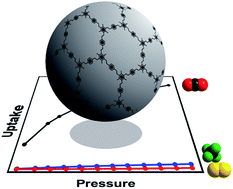当前位置:
X-MOL 学术
›
J. Mater. Chem. A
›
论文详情
Our official English website, www.x-mol.net, welcomes your feedback! (Note: you will need to create a separate account there.)
Fabrication of microporous polymers for selective CO2 capture: the significant role of crosslinking and crosslinker length
Journal of Materials Chemistry A ( IF 11.9 ) Pub Date : 2017-10-19 00:00:00 , DOI: 10.1039/c7ta07188d Sachin Mane 1, 2, 3, 4, 5 , Zhen-Yu Gao 1, 2, 3, 4, 5 , Yu-Xia Li 1, 2, 3, 4, 5 , Ding-Ming Xue 1, 2, 3, 4, 5 , Xiao-Qin Liu 1, 2, 3, 4, 5 , Lin-Bing Sun 1, 2, 3, 4, 5
Journal of Materials Chemistry A ( IF 11.9 ) Pub Date : 2017-10-19 00:00:00 , DOI: 10.1039/c7ta07188d Sachin Mane 1, 2, 3, 4, 5 , Zhen-Yu Gao 1, 2, 3, 4, 5 , Yu-Xia Li 1, 2, 3, 4, 5 , Ding-Ming Xue 1, 2, 3, 4, 5 , Xiao-Qin Liu 1, 2, 3, 4, 5 , Lin-Bing Sun 1, 2, 3, 4, 5
Affiliation

|
Owing to their high physicochemical stability, low skeletal density, tailorable surface properties, and high porosity, microporous crosslink polymers are highly promising for selective CO2 capture, separation, and storage. The crosslinking (CL) and crosslinker length (CLL) in a polymer play a quite significant role in enhancing selective CO2 capture. To investigate the role of CL and CLL, polymers with no crosslinking (non-crosslinking, NCL), and small-(SCL), and long-crosslinker lengths (LCL) were successfully fabricated. It is noteworthy that the polymer containing SCL has remarkable CO2 adsorption capacity and selectivity over the polymer with LCL and NCL. High selectivity for CO2 over CH4/N2 was observed in the sequence SCL > LCL > NCL. This indicates that not only CL but CLL is also significantly important in generating highly efficient adsorbents. The adsorption capacity reaches 208.3 mg g−1, which is higher than that of the benchmarks including activated carbon (122.8 mg g−1), and 13X zeolite (180.3 mg g−1), as well as most reported carbon-based adsorbents. The CO2/N2 and CO2/CH4 selectivity reaches 541.4 and 64, respectively. Moreover, excellent recyclability was observed without loss in CO2 adsorption for 10 cycles. Thus, high CO2 capture, excellent selectivity, and high recyclability under energy-saving mild regeneration conditions make microporous polymers a unique adsorbent for selective CO2 capture from flue gas and natural gas.
中文翻译:

用于选择性捕获CO 2的微孔聚合物的制备:交联和交联剂长度的重要作用
由于其高的物理化学稳定性,低的骨架密度,可定制的表面特性以及高的孔隙率,微孔交联聚合物对于选择性的CO 2捕获,分离和储存非常有前途。聚合物中的交联(CL)和交联剂长度(CLL)在增强选择性CO 2捕获方面起着相当重要的作用。为了研究CL和CLL的作用,成功地制备了没有交联(非交联,NCL)和小(SCL)和长交联剂长度(LCL)的聚合物。值得注意的是,含有SCL的聚合物比具有LCL和NCL的聚合物具有显着的CO 2吸附能力和选择性。在CH 4 / N 2之上对CO 2的高选择性顺序为SCL> LCL> NCL。这表明不仅CL而且CLL在产生高效吸附剂方面也非常重要。吸附容量达到208.3 mg g -1,高于包括活性炭(122.8 mg g -1)和13X沸石(180.3 mg g -1)以及大多数报告的基于碳的吸附剂的基准测试值。CO 2 / N 2和CO 2 / CH 4的选择性分别达到541.4和64。此外,在10个循环中观察到优异的可回收性,而没有损失CO 2吸附。因此,高CO 2捕获,优异的选择性和在节能的温和再生条件下的高可回收性使微孔聚合物成为从烟气和天然气中选择性捕获CO 2的独特吸附剂。
更新日期:2017-11-14
中文翻译:

用于选择性捕获CO 2的微孔聚合物的制备:交联和交联剂长度的重要作用
由于其高的物理化学稳定性,低的骨架密度,可定制的表面特性以及高的孔隙率,微孔交联聚合物对于选择性的CO 2捕获,分离和储存非常有前途。聚合物中的交联(CL)和交联剂长度(CLL)在增强选择性CO 2捕获方面起着相当重要的作用。为了研究CL和CLL的作用,成功地制备了没有交联(非交联,NCL)和小(SCL)和长交联剂长度(LCL)的聚合物。值得注意的是,含有SCL的聚合物比具有LCL和NCL的聚合物具有显着的CO 2吸附能力和选择性。在CH 4 / N 2之上对CO 2的高选择性顺序为SCL> LCL> NCL。这表明不仅CL而且CLL在产生高效吸附剂方面也非常重要。吸附容量达到208.3 mg g -1,高于包括活性炭(122.8 mg g -1)和13X沸石(180.3 mg g -1)以及大多数报告的基于碳的吸附剂的基准测试值。CO 2 / N 2和CO 2 / CH 4的选择性分别达到541.4和64。此外,在10个循环中观察到优异的可回收性,而没有损失CO 2吸附。因此,高CO 2捕获,优异的选择性和在节能的温和再生条件下的高可回收性使微孔聚合物成为从烟气和天然气中选择性捕获CO 2的独特吸附剂。



























 京公网安备 11010802027423号
京公网安备 11010802027423号